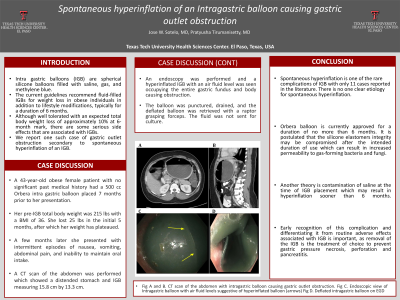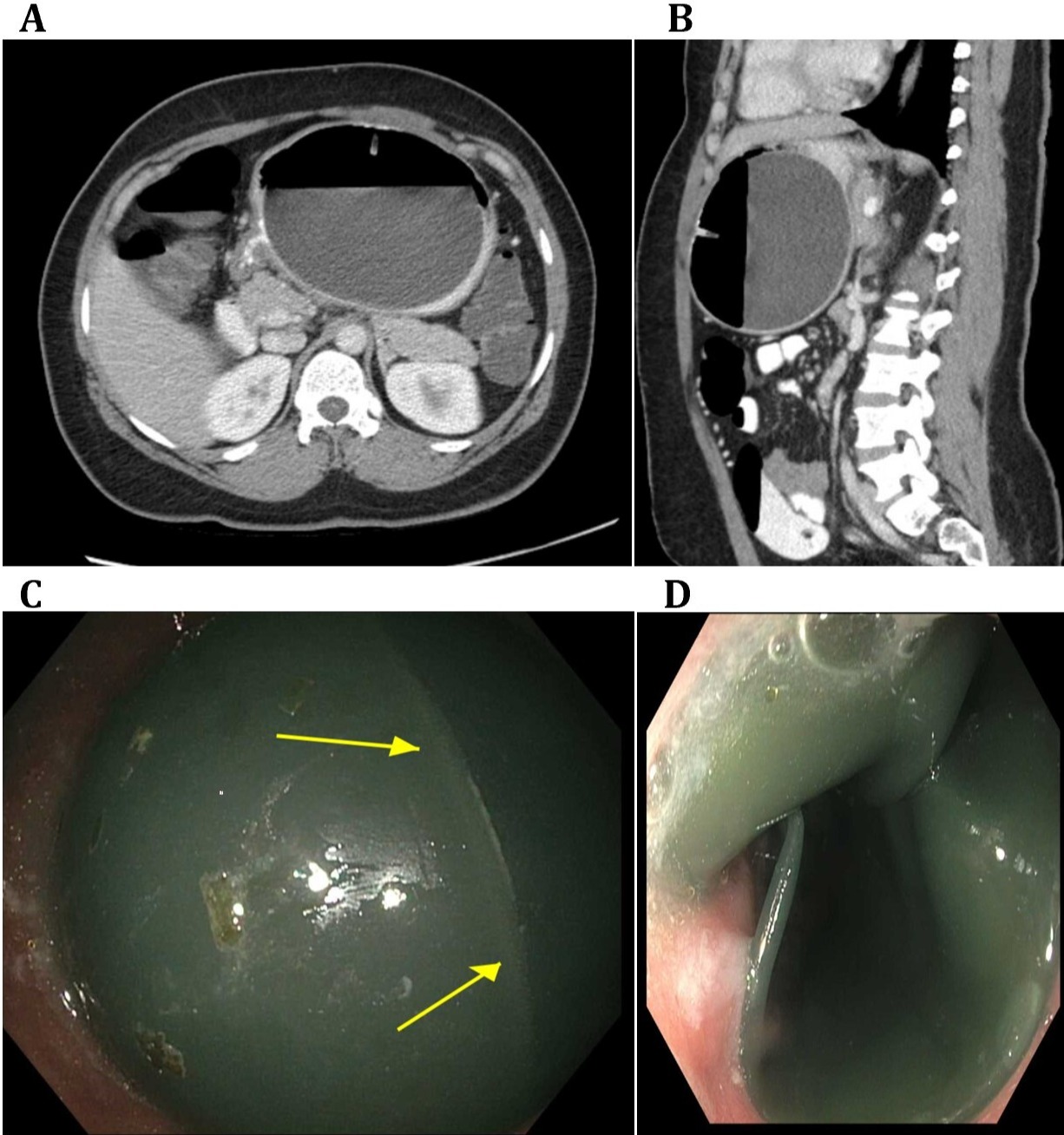Tuesday Poster Session
Category: Obesity
P4043 - Spontaneous Hyperinflation of an Intragastric Balloon Causing Gastric Outlet Obstruction
Tuesday, October 24, 2023
10:30 AM - 4:00 PM PT
Location: Exhibit Hall

Has Audio
- JS
Jose W. Sotelo, MD
Texas Tech University Health Sciences Center
El Paso, TX
Presenting Author(s)
Pratyusha Tirumanisetty, MD1, Jose W. Sotelo, MD2
1Brooklyn Hospital Center, Brooklyn, NY; 2Texas Tech University Health Sciences Center, El Paso, TX
Introduction: Intra gastric balloons (IGB) are spherical silicone balloons filled with saline, gas, methylene blue. The current guidelines recommend fluid filled IGBs for weight loss in obese individuals in addition to life style modifications, typically for a duration of 6 months. Although well tolerated with an expected total body weight loss of approximately 10% at 6-month mark, there are some serious side effects that are associated with IGBs. We report one such case of gastric outlet obstruction secondary to spontaneous hyperinflation of an IGB.
Case Description/Methods: A 43-year-old obese female patient with no significant past medical history had a 500 cc Orbera intra gastric balloon placed 7 months prior to her presentation. Her pre IGB total body weight was 215 lbs with a BMI of 36. She lost 25 lbs in the initial 5 months, after which her weight has plateaued. Few months later she presented with intermittent episodes of nausea, vomiting, abdominal pain and inability to maintain oral intake. A CT scan of the abdomen was performed which showed distended stomach and IGB measuring 15.8 cm by 13.3 cm. An endoscopy was performed and a hyperinflated IGB with an air fluid level was seen occupying the entire gastric fundus and body causing obstruction. The balloon was punctured, drained, and the deflated balloon was retrieved with a raptor grasping forceps. The fluid was not sent for culture.
Discussion: Spontaneous hyperinflation is one of the rare complications of IGB with only 11 cases reported in the literature. There is no one clear etiology for spontaneous hyperinflation. Orbera balloon is currently approved for a duration no more than 6 months. It is postulated that the silicone elastomers integrity may be compromised after the intended duration of use which can result in increased permeability to gas forming bacteria and fungi. Another theory is contamination of saline at the time of IGB placement which may result in hyperinflation sooner than 6 months. Early recognition of this complication and differentiating it from routine adverse effects associated with IGB is important, as removal of the IGB is the treatment of choice to prevent gastric pressure necrosis, perforation and pancreatitis.

Disclosures:
Pratyusha Tirumanisetty, MD1, Jose W. Sotelo, MD2. P4043 - Spontaneous Hyperinflation of an Intragastric Balloon Causing Gastric Outlet Obstruction, ACG 2023 Annual Scientific Meeting Abstracts. Vancouver, BC, Canada: American College of Gastroenterology.
1Brooklyn Hospital Center, Brooklyn, NY; 2Texas Tech University Health Sciences Center, El Paso, TX
Introduction: Intra gastric balloons (IGB) are spherical silicone balloons filled with saline, gas, methylene blue. The current guidelines recommend fluid filled IGBs for weight loss in obese individuals in addition to life style modifications, typically for a duration of 6 months. Although well tolerated with an expected total body weight loss of approximately 10% at 6-month mark, there are some serious side effects that are associated with IGBs. We report one such case of gastric outlet obstruction secondary to spontaneous hyperinflation of an IGB.
Case Description/Methods: A 43-year-old obese female patient with no significant past medical history had a 500 cc Orbera intra gastric balloon placed 7 months prior to her presentation. Her pre IGB total body weight was 215 lbs with a BMI of 36. She lost 25 lbs in the initial 5 months, after which her weight has plateaued. Few months later she presented with intermittent episodes of nausea, vomiting, abdominal pain and inability to maintain oral intake. A CT scan of the abdomen was performed which showed distended stomach and IGB measuring 15.8 cm by 13.3 cm. An endoscopy was performed and a hyperinflated IGB with an air fluid level was seen occupying the entire gastric fundus and body causing obstruction. The balloon was punctured, drained, and the deflated balloon was retrieved with a raptor grasping forceps. The fluid was not sent for culture.
Discussion: Spontaneous hyperinflation is one of the rare complications of IGB with only 11 cases reported in the literature. There is no one clear etiology for spontaneous hyperinflation. Orbera balloon is currently approved for a duration no more than 6 months. It is postulated that the silicone elastomers integrity may be compromised after the intended duration of use which can result in increased permeability to gas forming bacteria and fungi. Another theory is contamination of saline at the time of IGB placement which may result in hyperinflation sooner than 6 months. Early recognition of this complication and differentiating it from routine adverse effects associated with IGB is important, as removal of the IGB is the treatment of choice to prevent gastric pressure necrosis, perforation and pancreatitis.

Figure: Fig A and B. CT scan of the abdomen with intragastric balloon causing gastric outlet obstruction.
Fig C. Endoscopic view of Intragastric balloon with air fluid levels suggestive of hyperinflated balloon (arrows)
Fig D. Deflated intragastric balloon on EGD
Fig C. Endoscopic view of Intragastric balloon with air fluid levels suggestive of hyperinflated balloon (arrows)
Fig D. Deflated intragastric balloon on EGD
Disclosures:
Pratyusha Tirumanisetty indicated no relevant financial relationships.
Jose Sotelo indicated no relevant financial relationships.
Pratyusha Tirumanisetty, MD1, Jose W. Sotelo, MD2. P4043 - Spontaneous Hyperinflation of an Intragastric Balloon Causing Gastric Outlet Obstruction, ACG 2023 Annual Scientific Meeting Abstracts. Vancouver, BC, Canada: American College of Gastroenterology.
